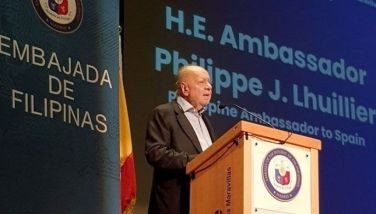Rizal and term paper writing made easy

August 26, 2002 | 12:00am
 The decision of De La Salle University Press to issue two college workbooks on the teaching of courses on Rizal and the dreaded term paper writing (sometimes known as English 2) as trade books may set a kind of precedent in local publishing. In so doing, the books A Workbook on a Course in Rizal by Jose Fadul, and Thinking and Writing Research (A Complete Guide to Independent Research Paper Writing) by Sterling Plata, Josephine Mirador, Danilo Dayag and Hannah Faye Chua, can in fact be purchased in a regular bookstore by any layman or aspiring teacher wanting to broaden his knowledge on Rizal and/or research.
The decision of De La Salle University Press to issue two college workbooks on the teaching of courses on Rizal and the dreaded term paper writing (sometimes known as English 2) as trade books may set a kind of precedent in local publishing. In so doing, the books A Workbook on a Course in Rizal by Jose Fadul, and Thinking and Writing Research (A Complete Guide to Independent Research Paper Writing) by Sterling Plata, Josephine Mirador, Danilo Dayag and Hannah Faye Chua, can in fact be purchased in a regular bookstore by any layman or aspiring teacher wanting to broaden his knowledge on Rizal and/or research.
Although by themselves as textbooks they are already rather ideal as instructional materials, the DLSU Press, in presenting them as trade books, automatically casts aside the preconception of their being strictly joyless academic stuff.
The two books, thus, serve both college students and teachers well in that the concerned courses, last we looked, were still included in the general education curriculum for a college degree: term paper writing, and the life and works of Rizal, in the University of the Philippines, in our time, known as PI 100.
Their being GE courses made them usually boring affairs, save if the teacher was especially creative and lively. The two workbooks cannot but help liven up the tediousness of research paper writing and re-reading the works of Rizal, the latter of which stretches back to the elementary grades.
At the old UP College of Arts and Sciences, English 2 was taken in the second semester of the freshman year, while PI 100 either in the junior or senior year.
Research today has greatly changed with the advent of the Internet, and the workbook Thinking and Writing Research acknowledges this by providing a helpful guide through cyberspace.
The Internet has changed not only college research paper writing but the entire youth culture, as seen in the number of Internet cafes that sprout near university campuses.
This has greatly eased the tediousness of being confined to the library, where we spent most of our English 2 class hours in the not too far-flung past.
What the new workbook does to the course is impart to the student that there is an art in the writing of the term paper, from the system of filing and writing notes on note cards, to the classifying of the bibliography, to topic sentence writing, outlining and writing the first draft all the way to the "finished product," as we call it today.
Not the finished product as we came to know it after promenading the length and breadth of Avenida and C.M. Recto, with intermittent hawkers selling ready-made term papers on the topic of your choice, and the occasional shady character whispering conspiratorially, "BTS, boy, BTS?"
The Internet may have forever changed research writing but this has not erased such moonlighters off the face of Sta. Cruz.
And our teacher in college, may she rest in peace, did little to make the learning a little bit more expolorative, such a stickler she was to the rules of the term paper writing trade, down to the margin measurements in the note cards. If there was even a slightest hint of plagiarism in the paper then good luck to the suspect of dishonesty.
One student whose case our teacher was consistently on even commented that he would have her raped by his muchacho, the death penalty not yet being meted to rapists.
As for Fadul’s workbook on Rizal, this attempts to do for the course what the term paper workbook does for English 2.
Various activities encourage the reader of Rizal to compare the hero’s works with such pop novelties as Latin-American soap operas; far from trivializing the Filipino masterpieces originally written in Spanish, the exercise in fact puts Rizal in a more contemporary light.
Other exercises include constructing timelines in world events coinciding with the time of Rizal, kite-flying, rap lyric writing, and other educational experiments even tangentially related to Rizal’s works, be it a chapter in the Noli or Fili, or an obscure passage in a poem or essay.
What a great help Fadul’s book would be to teachers of PI 100 groping on ways and means to make the required course more interesting and attuned to the times. As with the research paper workbook, there are also some exercises here that make use of the Internet, as any course in the new millennium rightfully should.
In the old days at UP, our professor at the time had to resort to group dynamics to get us to come up with projects on Rizal, including possible field trips to the foot of Mt. Banahaw to make the acquaintance of the Rizaliana sect Tres Persona Solo Dios.
For some reason at the end of the semester our teacher was given a rousing ovation, which stunned not a few students into thinking that perhaps the applause was an expression of relief that the school year had finally ended.
Would the Fadul workbook inspire similar applause at the end of the course? It is actually only a guide and teaching aide for the teacher, who in the long run has to make it all come together while transposing Rizal into a postmodern setting.
BrandSpace Articles
<
>



















